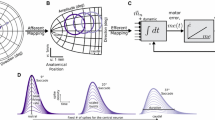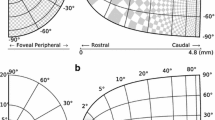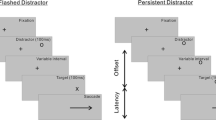Abstract.
Variable saccade trajectories are produced in visual search paradigms in which multiple potential target stimuli are present. These variable trajectories provide a rich source of information that may lead to a deeper understanding of the basic control mechanisms of the saccadic system. We have used published behavioral observations and neural recordings in the superior colliculus (SC), gathered in monkeys performing visual search paradigms, to guide the construction of a new distributed model of the saccadic system. The new model can account for many of the variations in saccade trajectory produced by the appearance of multiple visual stimuli in a search paradigm. The model uses distributed feedback about current eye motion from the brainstem to the SC to reduce activity there at physiologically realistic rates during saccades. The long-range lateral inhibitory connections between SC cells used in previous models have been eliminated to match recent physiological evidence. The model features interactions between visually activated multiple populations of cells in the SC and distributed and topologically organized inhibitory input to the SC from the SNr to produce some of the types of variable saccadic trajectories, including slightly curved and averaging saccades, observed in visual search tasks. The distributed perisaccadic disinhibition of SC from the substantia nigra (SNr) is assumed to have broad spatial tuning. In order to produce the strongly curved saccades occasionally recorded in visual search, the existence of a parallel input to the saccadic burst generators in addition to that provided by the distributed input from the SC is required. The spatiotemporal form of this additional parallel input is computed based on the assumption that the input from the model SC is realistic. In accordance with other recent models, it is assumed that the parallel input comes from the cerebellum, but our model predicts that the parallel input is delayed during highly curved saccadic trajectories.
Similar content being viewed by others
References
Anderson RW, Keller EL, Gandhi NJ, Das S (1998) Two-dimensional saccade-related population activity in superior colliculus in monkey. J Neurophysiol 80:798–817
Arai K, Das S, Keller EL, Aiyoshi E (1999) A distributed model of the saccade system: simulations of temporally perturbed saccades using position and velocity feedback. Neural Netw 12:1359–1375
Arai K, Keller EL, Edelman JA (1994) Two-dimensional neural network model of the primate saccadic system. Neural Netw 7:1115–1135
Arai K, McPeek RM, Keller EL (2004) Properties of saccadic responses in monkey when multiple competing visual stimuli are present. J Neurophysiol 91:890–900
Badler JB, Keller EL (2002) Decoding of a motor command vector from distributed activity in superior colliculus. Biol Cybern 86:179–189
Basso MA, Wurtz RH (1998) Modulation of neuronal activity in superior colliculus by changes in target probability. J Neurosci 18:7519–7534
Basso MA, Wurtz RH (2002) Neuronal activity in substantia nigra pars reticulata during target selection. J Neurosci 22:1883–1894
Bayer HM, Handel A, Glimcher PW (2004) Eye position and memory saccade related responses in substantia nigra pars reticulata. Exp Brain Res 154:428–441
Bozis A, Moschovakis AK (1998) Neural network simulations of the primate oculomotor system: III . A one-dimensional, one-directional model of the superior colliculus. Biol Cybern 79:215–231
Chou IH, Sommer MA, Schiller PH (1999) Express averaging saccades in monkeys. Vis Res 39:4200–4216
Das S, Keller EL, Arai K (1996) A distributed model of the saccadic system: the effects of internal noise. Neurocomputing 11:245–269
Dean P (1995) Modelling the role of the cerebellar fastigial nuclei in producing accurate saccades: the importance of burst timing. Neuroscience 68:1059–1077
Droulez J, Berthoz A (1991) A neural network model of sensoritopic maps with predictive short-term memory properties. Proc Natl Acad Sci USA 88:9653–9657
Edelman JA, Keller EL (1998) Dependence on target configuration of express saccade-related activity in the primate superior colliculus. J Neurophysiol 80:1407–1426
Fuchs AF, Robinson FR, Straube A (1993) Role of the caudal fastigial nucleus in saccade generation: I . Neuronal discharge patterns. J Neurophysiol 70:1723–1740
Glimcher PW, Sparks DL (1992) Movement selection in advance of action in the superior colliculus. Nature 355:542–545
Goossens HHLM, Van Opstal AJ (2000) Blink-perturbed saccades in monkey: II . Superior colliculus activity. J Neurophysiol 83:3430–3452
Grossberg S, Roberts K, Aguilar M, Bullock D (1997) A neural model of multimodal adaptive saccadic eye movement control by superior colliculus. J Neurosci 17:9706–9725
Handel A, Glimcher PW (1999) Quantitative analysis of substantia nigra pars reticulata activity during a visually guided saccade task. J Neurophysiol 82:3458–3475
Handel A, Glimcher PW (2000) Contextual modulation of substantia nigra pars reticulata neurons. J Neurophysiol 83:3042–3048
Hartwich-Young R, Nelson JS, Sparks DL (1990) The perihypoglossal projection to the superior colliculus in the rhesus monkey. Vis Neurosci 4:29–42
Hikosaka O, Wurtz RH (1983a) Visual and oculomotor functions of monkey substantia nigra pars reticulata: III . Memory-contingent visual and saccade responses. J Neurophysiol 49:1268–1284
Hikosaka O, Wurtz RH (1983b) Visual and oculomotor functions of monkey substantia nigra pars reticulata: IV . Relationship of substantia nigra to superior colliculus. J Neurophysiol 49:1285–1301
Hikosaka O, Wurtz RH (1983c) Effects on eye movements of a GABA agonist and antagonist injected into monkey superior colliculus. Brain Res 272:368–372
Isa T, Endo T, Saito Y (1998) The visuo-motor pathway in the local circuit of the rat superior colliculus. J Neurosci 18:8496–8504
Jiang H, Stein BE, McHaffie JG (2003) Opposing basal ganglia processes shape midbrain visuomotor activity bilaterally. Nature 423:982–986
Johnson RA, Wichern DW (1988) Applied multivariate statistical analysis. Prentice-Hall, Upper Saddle River, NJ, pp 273–287
Karabelas AB, Moschovakis AK (1985) Nigral inhibitory termination on efferent neurons of the superior colliculus: an intracellular horseradish peroxidase study in the cat. J Comp Neurol 239:309–329
Koch C, Ullman S (1985) Shifts in selective visual attention: towards the underlying neural circuitry. Hum Neurobiol 4:219–227
Massone LE, Khoshaba T (1995) Local dynamic interactions in the collicular motor map: a neural network model. Network 6:1–18
McFarland JL, Fuchs AF (1992) Discharge patterns in nucleus prepositus hypoglossi and adjacent medial vestibular nucleus during horizontal eye movement in behaving macaques. J Neurophysiol 68:319–336
McPeek RM, Keller EL (2002a) Superior colliculus activity related to concurrent processing of saccade goals in a visual search task. J Neurophysiol 87:1805–1815
McPeek RM, Keller EL (2002b) Saccade target selection in the superior colliculus during a visual search task. J Neurophysiol 88:2019–2034
McPeek RM, Skavenski AA, Nakayama K (2000) Concurrent processing of saccades in visual search. Vis Res 40:2499–2516
McPeek RM, Han JH, Keller EL (2003) Competition between saccade goals in the superior colliculus produces saccade curvature. J Neurophysiol 89:2577–2590
Minken AWH, Van Opstal AJ, Van Gisbergen JAM (1993) Three-dimensional analysis of strongly curved saccades elicited by double-step stimuli. Exp Brain Res 93:521–533
Munoz DP, Istvan P (1998) Lateral inhibitory interactions in the intermediate layers of the monkey superior colliculus. J Neurophysiol 79:1193–1209
Ohtsuka K, Noda H (1991) Saccadic burst neurons in the oculomotor region of the fastigial nucleus of macaque monkeys. J Neurophysiol 65:1422–1434
Optican LM (1994) Control of saccade trajectory by the superior colliculus. In: Fuchs AF, Brandt T, Büttner U, Zee DS (eds) Contemporary ocular motor and vestibular research: a tribute to David A. Robinson. Georg Thieme, Stuttgart, pp 98–105
Özen G, Helms MC, Hall WC (2004) The intracollicular neuronal network. In: Hall WC, Moschovakis AK (eds) The superior colliculus: new approaches for studying sensorimotor integration. CRC Press, Boca Raton, FL, pp 147–158
Pettit DL, Helms MC, Lee P, Augustine GJ, Hall WC (1999) Local excitatory circuits in the intermediate gray layer of the superior colliculus. J Neurophysiol 81:1424–1427
Port NL, Wurtz RH (2003) Sequential activity of simultaneously recorded neurons in the superior colliculus during curved saccades. J Neurophysiol 90:1887–1903
Quaia C, Lefèvre P, Optican LM (1999) Model of the control of saccades by superior colliculus and cerebellum. J Neurophysiol 82:999–1018
Robinson FR (2000) Role of the cerebellar posterior interpositus nucleus in saccades: I . Effect of temporary lesions. J Neurophysiol 84:1289–1302
Robinson FR, Straube A, Fuchs AF (1993) Role of the caudal fastigial nucleus in saccade generation: II . Effects of muscimol inactivation. J Neurophysiol 70:1741–1758
Rodgers KC, Munoz DP, Scott SH, Pare M (2003) The activity carried by superior colliculus neurons is not a sufficient motor command. Soc Neurosci Abstr 79(2):388
Schall JD, Thompson KG (1999) Neural selection and control of visually guided eye movements. Annu Rev Neurosci 22:241–259
Soetedjo R, Kaneko CRS, Fuchs AF (2002) Evidence that the superior colliculus participates in the feedback control of saccadic eye movements. J Neurophysiol 87:679–695
Sommer MA, Wurtz RH (2000) Composition and topographic organization of signals sent from the frontal eye field to the superior colliculus. J Neurophysiol 83:1979–2001
Stanford TR, Freedman EG, Sparks DL (1996) Site and parameters of microstimulation: evidence for independent effects on the properties of saccades evoked from the primate superior colliculus. J Neurophysiol 76:3360–3381
Takagi M, Zee DS, Tamargo RJ (1998) Effects of lesions of the oculomotor vermis on eye movements in primate: saccades. J Neurophysiol 80:1911–1931
Thier P, Dicke PW, Haas R, Barash S (2000) Encoding of movement time by populations of cerebellar Purkinje cells. Nature 405:72–76
Van Gisbergen JAM, Robinson DA, Gielen S (1981) A quantitative analysis of generation of saccadic eye movements by burst neurons. J Neurophysiol 45:417–441
Van Opstal AJ, Van Gisbergen JAM (1989) A nonlinear model for collicular spatial interactions underlying the metrical properties of electrically elicited saccades. Biol Cybern 60:171–183
Waitzman DM, Ma TP, Optican LM, Wurtz RH (1991) Superior colliculus neurons mediate the dynamic characteristics of saccades. J Neurophysiol 66:1716–1737
Waitzman DM, Silakov VL, DePalma-Bowles S, Ayers AS (2000) Effects of reversible inactivation of the primate mesencephalic reticular formation: I . Hypermetric goal-directed saccades. J Neurophysiol 83:2260–2284
Walker MF, FitzGibbon EJ, Goldberg ME (1995) Neurons in the monkey superior colliculus predict the visual result of impending saccadic eye movements. J Neurophysiol 73:1988–2003
Yuille AL, Grzywacz NM (1989) A winner-take-all mechanism based on presynaptic inhibition feedback. Neural Comput 1:334–347
Author information
Authors and Affiliations
Corresponding author
Rights and permissions
About this article
Cite this article
Arai, K., Keller, E. A model of the saccade-generating system that accounts for trajectory variations produced by competing visual stimuli. Biol Cybern 92, 21–37 (2005). https://doi.org/10.1007/s00422-004-0526-y
Received:
Accepted:
Published:
Issue Date:
DOI: https://doi.org/10.1007/s00422-004-0526-y




